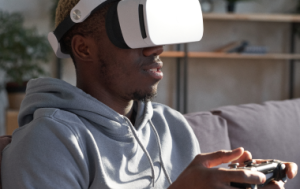

The promise of being completely absorbed into a digital realm, of stepping into the shoes of a protagonist, has been the dream of gamers since the dawn of video games. And with the advent and growth of virtual reality (VR) technology, that dream is closer than ever to becoming a tangible reality.
Virtual Reality’s inception in the gaming world was met with both awe and skepticism. While its potential was clear from the outset, the technology faced numerous hurdles. Bulky headsets, expensive setups, and the lack of substantial game libraries were just a few of the initial challenges. But as with all technologies, VR has undergone rapid evolution, maturing in both its hardware and the experiences it offers.
Modern VR systems are a testament to this growth. Sleeker designs, improved resolution, decreased latency, and more intuitive controllers have transformed the VR gaming experience from a novelty to a fully immersive experience. The tethered confines of the past have made way for room-scale experiences where players can walk, jump, and interact more naturally with their virtual environments.
The games themselves have undergone a metamorphosis. No longer are they just simple demos or short experiences; they now offer full-fledged narratives, intricate gameplay mechanics, and graphics that can rival traditional gaming platforms. Games like “Half-Life: Alyx” showcase the potential of VR as a storytelling medium, blending classic game mechanics with the unique opportunities VR presents.
But beyond the games and the technology, VR’s implications stretch further. The sense of presence that VR provides can have profound emotional and psychological impacts. Horror games become more terrifying, adventures feel grander, and emotional narratives hit closer to home when you’re “living” them. This immersion can also be therapeutic, with VR being explored as a tool for treating PTSD, phobias, and more.
However, challenges remain. Motion sickness remains a barrier for a segment of players, and the entry cost, though decreasing, is still high for many. Accessibility features are essential to ensure all gamers can enjoy what VR has to offer, and developers need to remain cognizant of the physical demands and constraints when designing VR games.
The future of VR gaming remains bright. With advances in augmented reality (AR) technology, the line between the real and virtual world will blur even further. Concepts like haptic feedback suits and more advanced tactile interfaces could further deepen the immersion, allowing players to “feel” the game.
In essence, VR stands at the frontier of the gaming world, pushing the boundaries of what’s possible. As the technology matures and becomes even more integrated into mainstream gaming, one can only imagine the experiences awaiting gamers in the near future.
Share this post



Your Portal to Gaming Adventure.
Where gaming is not just a hobby but a way of life
10 Responses
This is such an exciting time for VR gaming! I can’t believe how far the technology has come in just a few years. The immersive experiences are unlike anything we’ve ever seen before.
This post perfectly captures the evolution of VR. I’m excited to see how it continues to shape the gaming industry and our experiences.
Amazing insights! VR really is on the frontier of gaming. I hope to see more diverse games that cater to different audiences.
I’m really looking forward to seeing how VR evolves. The potential for storytelling and emotional connection in games is something we’ve only scratched the surface of!
I’m curious about how AR will blend with VR in the future. The possibilities for gameplay and real-world interactions are endless!
I do worry about motion sickness with VR, though. I hope developers continue to find ways to make the experience more comfortable for everyone.
The advancements in VR are astounding! I remember when the first VR headsets came out, and now we have games that are basically movies. Can’t wait for what’s next!
Great article! It’s fascinating to think about the therapeutic applications of VR. It could change the way we approach mental health treatment.
Half-Life: Alyx was a game changer! It really showed the potential of VR in creating deep and engaging narratives.
I agree that accessibility is crucial for the future of VR gaming. We need to make sure everyone can join in on the fun!